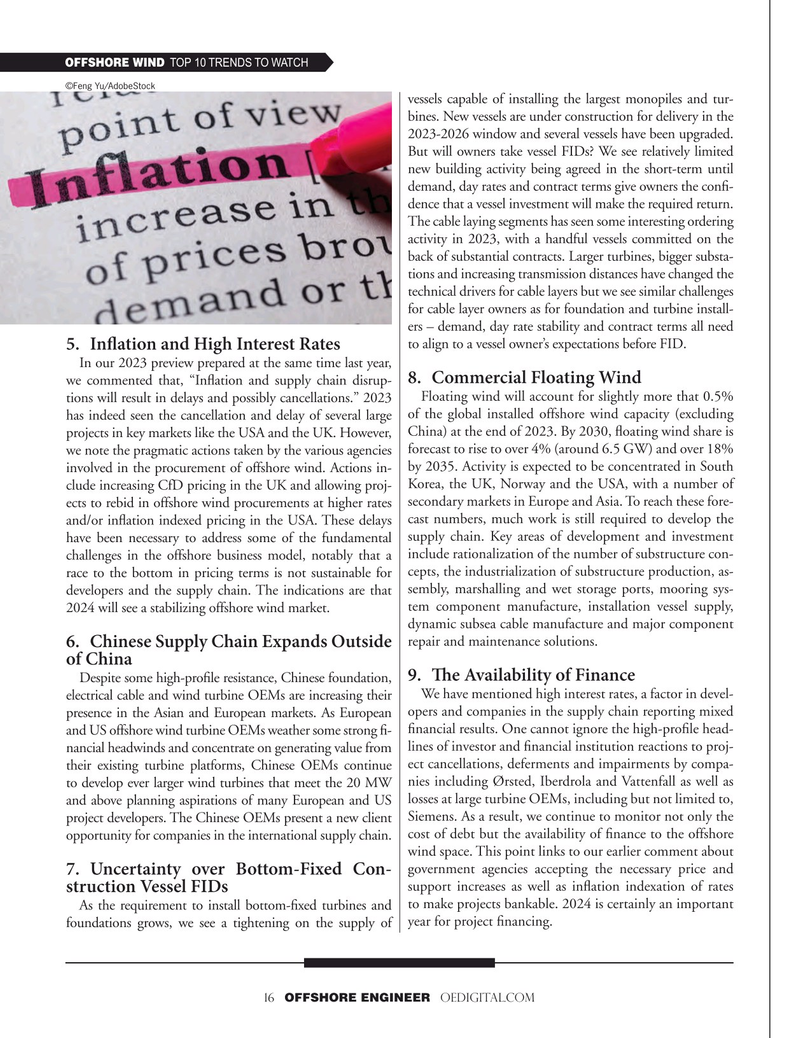
Page 16: of Offshore Engineer Magazine (Nov/Dec 2023)
Read this page in Pdf, Flash or Html5 edition of Nov/Dec 2023 Offshore Engineer Magazine
OFFSHORE WIND TOP 10 TRENDS TO WATCH ©Feng Yu/AdobeStock vessels capable of installing the largest monopiles and tur- bines. New vessels are under construction for delivery in the 2023-2026 window and several vessels have been upgraded.
But will owners take vessel FIDs? We see relatively limited new building activity being agreed in the short-term until demand, day rates and contract terms give owners the conf- dence that a vessel investment will make the required return.
The cable laying segments has seen some interesting ordering activity in 2023, with a handful vessels committed on the back of substantial contracts. Larger turbines, bigger substa- tions and increasing transmission distances have changed the technical drivers for cable layers but we see similar challenges for cable layer owners as for foundation and turbine install- ers – demand, day rate stability and contract terms all need to align to a vessel owner’s expectations before FID. 5. Infation and High Interest Rates
In our 2023 preview prepared at the same time last year, 8. Commercial Floating Wind we commented that, “Infation and supply chain disrup-
Floating wind will account for slightly more that 0.5% tions will result in delays and possibly cancellations.” 2023 has indeed seen the cancellation and delay of several large of the global installed offshore wind capacity (excluding projects in key markets like the USA and the UK. However, China) at the end of 2023. By 2030, foating wind share is we note the pragmatic actions taken by the various agencies forecast to rise to over 4% (around 6.5 GW) and over 18% by 2035. Activity is expected to be concentrated in South involved in the procurement of offshore wind. Actions in-
Korea, the UK, Norway and the USA, with a number of clude increasing CfD pricing in the UK and allowing proj- ects to rebid in offshore wind procurements at higher rates secondary markets in Europe and Asia. To reach these fore- and/or infation indexed pricing in the USA. These delays cast numbers, much work is still required to develop the have been necessary to address some of the fundamental supply chain. Key areas of development and investment challenges in the offshore business model, notably that a include rationalization of the number of substructure con- race to the bottom in pricing terms is not sustainable for cepts, the industrialization of substructure production, as- developers and the supply chain. The indications are that sembly, marshalling and wet storage ports, mooring sys- tem component manufacture, installation vessel supply, 2024 will see a stabilizing offshore wind market. dynamic subsea cable manufacture and major component repair and maintenance solutions.
6. Chinese Supply Chain Expands Outside of China 9. Te Availability of Finance
Despite some high-profle resistance, Chinese foundation,
We have mentioned high interest rates, a factor in devel- electrical cable and wind turbine OEMs are increasing their presence in the Asian and European markets. As European opers and companies in the supply chain reporting mixed fnancial results. One cannot ignore the high-profle head- and US offshore wind turbine OEMs weather some strong f- nancial headwinds and concentrate on generating value from lines of investor and fnancial institution reactions to proj- their existing turbine platforms, Chinese OEMs continue ect cancellations, deferments and impairments by compa- to develop ever larger wind turbines that meet the 20 MW nies including Ørsted, Iberdrola and Vattenfall as well as and above planning aspirations of many European and US losses at large turbine OEMs, including but not limited to, project developers. The Chinese OEMs present a new client Siemens. As a result, we continue to monitor not only the cost of debt but the availability of fnance to the offshore opportunity for companies in the international supply chain.
wind space. This point links to our earlier comment about government agencies accepting the necessary price and 7. Uncertainty over Bottom-Fixed Con- support increases as well as infation indexation of rates struction Vessel FIDs
As the requirement to install bottom-fxed turbines and to make projects bankable. 2024 is certainly an important foundations grows, we see a tightening on the supply of year for project fnancing.
16 OFFSHORE ENGINEER OEDIGITAL.COM

 15
15

 17
17